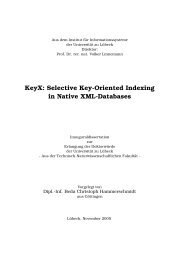„Einfluss der elektrischen Hochfrequenzstimulation des Nucleus ...
„Einfluss der elektrischen Hochfrequenzstimulation des Nucleus ...
„Einfluss der elektrischen Hochfrequenzstimulation des Nucleus ...
Sie wollen auch ein ePaper? Erhöhen Sie die Reichweite Ihrer Titel.
YUMPU macht aus Druck-PDFs automatisch weboptimierte ePaper, die Google liebt.
Abstract 1<br />
Abstract<br />
Since the work of Ebbinghaus, memory was thought to be just one process of<br />
acquisition, storage and transfer of association. But recently several studies<br />
could show that memory is characterized as a multiple system, consisting of<br />
many processes and at least two different types, conscious and unconscious<br />
memory. It could also be demonstrated that both memory types are mediated<br />
by different brain areas. Conscious memorization, also called as declarative<br />
memory, is induced by hippocampus whereas unconscious memory, also<br />
known as non-declarative or procedural memory, is mediated by caudate<br />
nucleus. Impairment of memory, existing in various neurological diseases like<br />
Parkinson’s disease, was treated for a long time just by drugs but since high<br />
frequency stimulation (HFS) has become an important therapy for different<br />
neurological and psychiatric diseases, different studies are investigating the<br />
effects of HFS on memory deficits. In previous in vitro and in vivo studies, it<br />
could be demonstrated that during HFS GABA outflow increased in caudate<br />
nucleus of rats. We therefore investigated the effect of striatal HFS<br />
application on procedural learning in rats and possible long-term effects of<br />
HFS on several neurotransmitter systems in caudate nucleus.<br />
In a first experiment, rats were trained in a plus maze for three days, twice a<br />
day, to look for a reward in an alternating but marked maze arm. Therefore,<br />
animals were divided into two groups, food deprived (FD) and food ad libitum<br />
(AdL) rats, and subdivided in each group into stimulated (STIM) and operated<br />
but not stimulated (SHAM) rats. After each training session, unilateral HFS of<br />
left caudate nucleus was performed over 4 hours in alternating 20 min<br />
periods. Nineteen hours after last HFS and immediately after a probe trial<br />
assessing the animals’ memory strategy, the rat brain was quickly removed<br />
and histological examination of the brain was performed to check the right<br />
position of the stimulation electrode in the left caudate nucleus. None of the<br />
animals showed a misplacement of the guide cannula and the electrode in<br />
the caudate nucleus, suggesting a high reliability of surgery. There was<br />
neither a large damage to the neuronal tissue nor an extended gliosis around

















